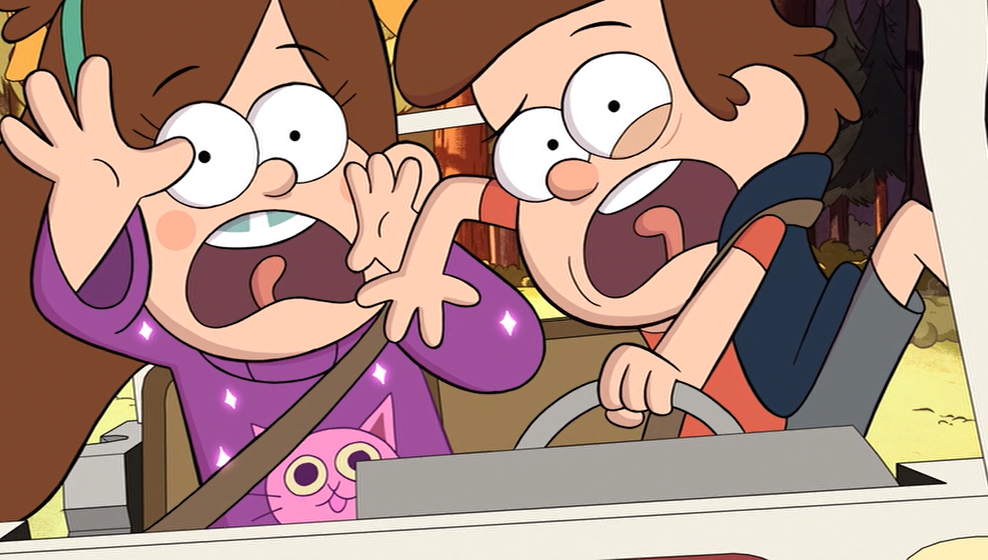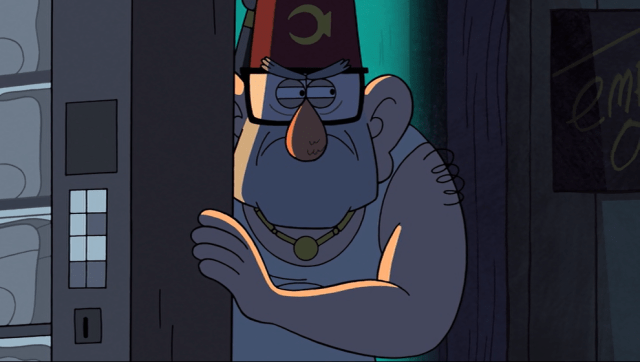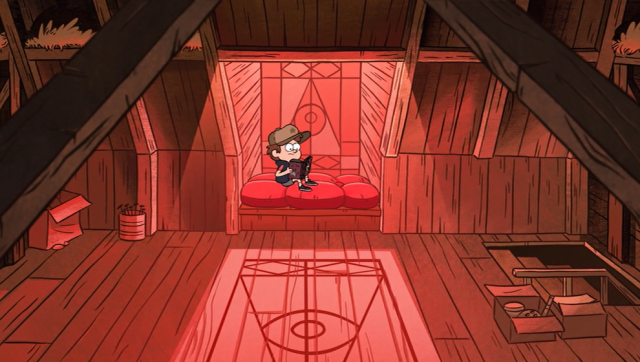Not to start things off with too much hype, but this remains one of the most flawlessly executed premieres I’ve ever seen.
The Plot
Dipper relates the tale of how he came to find a mysterious journal in the woods of Gravity Falls, and becomes determined to use it to solve and chronicle the mysteries of the sleepy little town. His first case? Trying to keep his sister Mabel from being drawn in by the clearly sinister creature masquerading as her boyfriend.
A lot of the legwork of this episode, by necessity, has to cover things laid out in the introduction to these recaps: the conceit of the show, the setting and mood, and the characters and their relationships to one another. And while it’s pretty common for a show to take some time in finding its voice, this one hits the ground running in terms of giving accurate first impressions of the characters (the exception might be Soos, whose Wise Mysterious Helper angle is a comparatively minor part of his eager, goofy personality in the long haul). The script keeps a tight focus on Dipper and Mabel, making their bond the meat of the episode and giving just enough context to come back to later. More importantly, every character is given a chance to show that they genuinely like each other, a tenderness that’s all too frequently absent from sibling-focused comedies and a big part of what makes Gravity Falls so special.
It’s easy to take for granted how beautiful this show is to look at, no doubt because the Disney stamp puts an assumption in a lot of minds. But that doesn’t mean we shouldn’t step back and marvel at the fluidity of moments like Dipper driving the golf cart down a steep cliff, or the popping, almost painted jewel tones of the woods. The production style is a little bit unusual by modern cartoon standards: in addition to being 22 minutes rather than 11, it’s a script-driven show. Most modern cartoons (including Adventure Time and Steven Universe) are board-driven, meaning that the crew sketches out the story they want in broad terms and then draw it out, refining the details to match the drawings. For GF, the boarding and animation follows a completed script, with all dialogue and action already set out (though of course it might change during the process). This script driven style is more common with older shows including The Simpsons, which leaves a mark in a big way (even in this episode, Dipper’s “bewarb” bug bites are a reference to a Simpsons gag). That’s no knock—all shows are the composite of what their creators loved growing up. And later it’s going to affect the writing team, too (you can hear Alex talk pretty adorably about his love for the show here).
The gnomes might be just about the perfect choice as a premiere monster, too. Even if it means the “gnome vomiting rainbows” image was the closest thing you could find to a promotional image for a long, long time (we’ll save Disney’s wretched marketing regarding this show for another day). Not only are the gnomes a sort of visual training for how the show will use foreshadowing later on—the first page Dipper turns to is the gnomes, he accidentally turns to it when trying to show Mabel before redirecting to the assumed right answer – and an effective showcase of how the Journal is both a help and a hindrance (Dipper, with Mabel’s help, has to find the gnomes’ weakness because the book doesn’t provide it), but it proves an excellent foil for one of the show’s core themes. On their own, the gnomes are easily handled and comical, if a bit eerie with their pointy teeth. Together they’re a formidable force, and it’s ultimately by breaking down that team dynamic that Dipper and Mabel are able to win (additionally, they’re all a group following a leader blindly rather than a team of equals). It makes a fantastic foil to Dipper’s attempts to yell sense to Mabel rather than talking with her, and they’ve both grown when they acknowledge each other’s strengths and weaknesses. Trust, forgiveness, and family are always the name of the game at the end of the day. Even down to what’s behind that spooky vending machine.
Today in Fandom
The thing you have to know about Gravity Falls fandom is that It was, in its heyday, not unlike being a Dark Souls player. Information was dissected and shared as quickly as possible in order to further a communal think-tank of theorizing that was only sometimes plagued with blatant trolling (a lot of which came from Alex Hirsch himself). Now, the hit to miss ratio of those theories fell on a pretty broad spectrum, but the amount of creativity and calculation was pretty incredible nonetheless. Even before Rick & Morty came along (no coincidence that Justin Roiland is close friends with Hirsch) with its conception of infinite timelines, I’ve never seen a show that so thoroughly embraced not just the idea of diverging plot possibilities but the whole rabbit hole of how far those ideas could go. We’ll come back to some of them later.
In neat random factoid news, the show debuted on the same day as Welcome to Night Vale. I’ll give you a minute to look up the discrepancy in number of episodes released since then, and retroactively despair.
You’ll also notice that 618 is a recurrent number throughout the series (you can see it here on the cash register, for instance). While much was made of this mystery at the time, I can save you some time and tears by telling you it’s a little inside joke, referencing Alex and his twin sister Ariel’s birthday.
I’m torn as to whether to include Twitter factoids in these recaps, because they had a habit of disappearing the day after Hirsch hosted a Q&A and are thus difficult to source. But for the record, it was indeed jam. From the gnome queen’s funeral. No sense wasting any time, I guess.
And, as part of the language of visual storytelling, the loss and replacement of Dipper’s hat is meant to be a clue that change will be permanent and continuity consistent from episode to episode, even if it doesn’t seem like it at first.
Ciphers
A HUGE thanks to the Gravity Falls Wiki for having easy-to-reference info on the show’s cryptography. It’s an immeasurable help as I try to remember they eight million references and codes the show has on-offer.
Lesson one: nothing is to be taken at face value. That “trust no one” thing goes aaaaaaaaaaall the way down. If you listen quite closely to the last few seconds of the opening theme, you can hear a strange whispering. Crank that up, and it says “three letters back.” That’s a reference to the Caesar cipher, an actual form of cryptography which will help you decode the messages at the tail end of the credits. It ALSO decodes a very important message hidden in the opening itself.
OPENING CREDITS CIPHER: “Stan is not what he seems”
CREDITS CIPHER: Welcome to Gravity Falls
Most of the end credits codes are little jokes that Hirsch wrote when he had a spare minute during production, but keep that decoding muscle handy. I’d also recommend freeze-framing the journal pages. There are a lot of neat hidden jokes there.
Spoiler Corner
One last warning: as the name might imply, this section is for folks who’ve seen the series before and are looking for second-watch stuff. Tread carefully
Since this episode is so prominently about the twins, there’s not a whole lot referencing the greater mystery here, but you might want to take a look at some of the wall decorations. There is a LOT of twin imagery decorating the Shack. This is also the first appearance of “eenie meenie miney YOU,” the first of several parallels that will form a through-line to the final episode.
Speaking of throwaway jokes, check out the “Cursed Door” journal page, which features the gem “Knock knock. Who’s there? THE FORCES OF EVIL.” Bad, dorky jokes are apparently in the blood.
And, of course, there is the first scene of Dipper consulting the journal for help (which, on this watch, is easily my favorite image). Not only is he sitting in the shadow of the eye-window, but the camera looks at him through the triangular “I”-beams of the attic roof. Crafty are the Hirschlord’s ways, and deep are his designs.
Want to share this on Tumblr? There’s a post for that!
Vrai is a queer author and pop culture blogger; they’re not sure if they should be worried about the triangles staring back at them. You can read more essays and find out about their fiction at Fashionable Tinfoil Accessories, support their work via Patreon or PayPal, or remind them of the existence of Tweets.
(image via Disney)
—Please make note of The Mary Sue’s general comment policy.—
Do you follow The Mary Sue on Twitter, Facebook, Tumblr, Pinterest, & Google +?











Published: Feb 24, 2016 12:45 pm